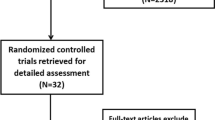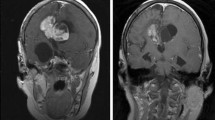Abstract
mTOR inhibitors represent a relatively new therapeutic option in the management of patients affected by tuberous sclerosis complex (TSC). Randomized clinical trials support the use of everolimus in the treatment of subependymal giant cell astrocytomas (SEGA) and renal angiomyolipomas (AML) related to TSC. Accumulating data suggest also systemic disease-modifying potential of mTOR inhibitors.
Given that increasing number of patients with TSC receive mTOR inhibitors, the issue of adverse events associated with this therapy becomes practically important. In the present study we provide the overview of clinical manifestations and therapeutic options for the most common adverse events related to mTOR inhibitors in TSC patients.
Similar content being viewed by others
References
Laplante M, Sabatini DM. MTOR signaling in growth control and disease. Cell 2012;149:274–93.
Sarbassov DD, Ali SM, Sabatini DM. Growing roles for the mTOR pathway. Curr Opin Cell Biol 2005;17:596–603.
Curatolo P, Bombardieri R, Jóźwiak S. Tuberous sclerosis. Lancet 2008;372: 657–68.
Fryer AE, Chalmers A, Connor JM, Fraser I, Povey S, Yates AD, et al. Evidence that the gene for tuberous sclerosis is on chromosome 9. Lancet 1987;1:659–62.
The European Chromosome 16 Tuberous Sclerosis Consortium. Identification and characterization of the tuberous sclerosis gene on chromosome 16. Cell 1993;75:1305–15.
Manning BD, Tee AR, Logsdon MN, Blenis J, Cantley LC. Identification of the tuberous sclerosis complex-2 tumor suppressor gene product tuberin as a target of the phosphoinositide 3-kinase/Akt pathway. Mol Cell 2002;10:151–62.
Tee AR, Fingar DC, Manning BD, Kwiatkowski DJ, Cantley LC, Blenis J. Tuberous sclerosis complex-1 and -2 gene products function together to inhibit mammalian target of rapamycin (mTOR)-mediated downstream signaling. Proc Natl Acad Sci U S A 2002;99:13571–76.
Kenerson H, Dundon TA, Yeung RS. Effects of rapamycin in the eker rat model of tuberous sclerosis complex. Pediatr Res 2005;57:67–75.
Wienecke R, Fackler I, Linsenmaier U, Mayer K, Licht T, Kretzler M. Antitumoral activity of rapamycin in renal angiomyolipoma associated with tuberous sclerosis complex. Am J Kidney Dis 2006;48:27–9.
Franz DN, Leonard J, Tudor C, Chuck G, Care M, Sethuraman G, et al. Rapamycin causes regression of astrocytomas in tuberous sclerosis complex. Ann Neurol 2006;59:490–8.
Franz DN, Belousova E, Sparagana S, Bebin EM, Frost M, Kuperman R, et al. Efficacy and safety of everolimus for subependymal giant cell astrocytomas associated with tuberous sclerosis complex (EXIST-1): a multicentre, randomised, placebo-controlled phase 3 trial. Lancet 2013;381:125–32.
Bissler JJ, Kingswood JC, Radzikowska E, Zonnenberg BA, Frost M, Belousova E, et al. Everolimus for angiomyolipoma associated with tuberous sclerosis complex or sporadic lymphangioleiomyomatosis (EXIST-2): a multicentre, randomised, double-blind, placebo-controlled trial. Lancet 2013;381:817–24.
Kotulska K, Borkowska J, Jóźwiak S. Possible prevention of tuberous sclerosis complex lesions. Pediatrics 2013;132:239–42.
Vézina C, Kudelski A, Sehgal SN. Rapamycin (AY-22,989), a new antifungal antibiotic. I. Taxonomy of the producing streptomycete and isolation of the active principle. J Antibiot (Tokyo) 1975;28:721–6.
Simamora P, Alvarez JM, Yalkowsky SH. Solubilization of rapamycin. Int J Pharm 2001;213:25–9.
Mahalati K, Kahan BD. Clinical pharmacokinetics of sirolimus. Clin Pharmacokinet 2001;40:573–85.
Kirchner GI, Meier-Wiedenbach I, Manns MP. Clinical pharmacokinetics of everolimus. Clin Pharmacokinet 2004;43:83–95.
Jóźwiak S, Nabbout R, Curatolo P. Management of subependymal giant cell astrocytoma (SEGA) associated with tuberous sclerosis complex (TSC): clinical recommendations. Eur J Paediatr Neurol 2013;17:348–52.
Goyer I, Dahdah N, Major P. Use of mTOR inhibitor everolimus in three neonates for treatment of tumors associated with tuberous sclerosis complex. Pediatr Neurol 2015;52:450–3.
Breathnach C, Pears J, Franklin O, Webb D, McMahon J. Rapid regression of left ventricular outflow tract rhabdomyoma after sirolimus therapy. Pediatrics 2014;134:e1199–202.
Kotulska K, Chmielewski D, Borkowska J, Jurkiewicz E, Kuczyński D, Kmieć T, et al. Eur J Paediatr Neurol 2013;17:479–85.
Trotti A, Colevas AD, Setser A. Development of a comprehensive grading system for the adverse effects of cancer treatment. Semin Radiat Oncol 2003;13:176–81.
Franz DN, Agricola K, Mays M, Tudor C, Care MM, Holland-Bouley K, et al. Everolimus for subependymal giant cell astrocytoma: 5-year final analysis. Ann Neurol 2015;(September). http://dx.doi.org/10.1002/ana.24523 [Epub ahead of print].
Trelińska J, Dachowska I, Kotulska K, Fendler W, Jóźwiak S, Młynarski W. Complications of mammalian target of rapamycin inhibitor anticancer treatment among patients with tuberous sclerosis complex are common and occasionally life-threatening. Anticancer Drugs 2015;26:437–42.
Chuang P, Langone AJ. Clobetasol ameliorates aphthous ulceration in renal transplant patients on sirolimus. Am J Transplant 2007;7:714–7.
Agricola K, Tudor C, Krueger D, Neal D. Nursing implications for the lifelong management of tuberous sclerosis complex. J Neurosci Nurs 2013;45:223–39.
Boers-Doets CB, Raber-Durlacher JE, Treister NS, Epstein JB, Arends AB, Wiersma DR, et al. Mammalian target of rapamycin inhibitor-associated stomatitis. Future Oncol 2013;9:1883–92.
Atkins MB, Hidalgo M, Stadler WM, Logan TF, Dutcher JP, Hudes GR, et al. Randomized phase II study of multiple dose levels of CCI-779, a novel mammalian target of rapamycin kinase inhibitor, in patients with advanced refractory renal cell carcinoma. J Clin Oncol 2004;22:909–18.
Morelon E, Stern M, Israël-Biet D, Correas JM, Danel C, Mamzer-Bruneel MF, et al. Characteristics of sirolimus-associated interstitial pneumonitis in renal transplant patients. Transplantation 2001;72:787–90.
Pham P-TT, Pham P-CT, Danovitch GM, Ross DJ, Gritsch HA, Kendrick EA, et al. Sirolimus-associated pulmonary toxicity. Transplantation 2004;77:1215–20.
De Masson A, Fouchard N, Merry-Bossard L, Dauendorffer JN. Cutaneous and mucosal aphthosis during temsirolimus therapy for advanced renal cell carcinoma: review of cutaneous and mucosal side effects of mTOR inhibitors. Dermatology 2011;223:4–8.
Kraemer FB, Takeda D, Natu V, Sztalryd C. Insulin regulates lipoprotein lipase activity in rat adipose cells via wortmannin- and rapamycin-sensitive pathways. Metabolism 1998;47:555–9.
Tremblay F, Marette A. Amino acids and insulin signaling via the mTOR/p70 S6 kinase pathway. J Biol Chem 2001;4141:38052–60.
Hong JC, Kahan BD. Sirolimus-induced thrombocytopenia and leukopenia in renal transplant recipients: risk factors, incidence, progression, and management. Transplantation 2000;69:2085–90.
Krueger DA, Care MM, Agricola K, Tudor C, Mays M, Franz DN. Everolimus long-term safety and efficacy in subependymal giant cell astrocytoma. Neurology 2013;80:574–80.
Feng LX, Ravindranath N, Dym M. Stem cell factor/c-kit up-regulates cyclin D3 and promotes cell cycle progression via the phosphoinositide 3-kinase/p70 S6 kinase pathway in spermatogonia. J Biol Chem 2000;275:25572–76.
Roa J, Tena-Sempere M. Energy balance and puberty onset: emerging role of central mTOR signaling. Trends Endocrinol Metab 2010;21:519–28.
Yoshizaki A, Yanaba K, Yoshizaki A, Iwata Y, Komura K, Ogawa F, et al. Treatment with rapamycin prevents fibrosis in tight-skin and bleomycin-induced mouse models of systemic sclerosis. Arthritis Rheum 2010;62: 2476–87.
Öztunç F, Atik SU, Güneş AO. Everolimus treatment of a newborn with rhabdomyoma causing severe arrhythmia. Cardiol Young 2015;25:1411–4.
Mohamed I, Ethier G, Goyer I, Major P, Dahdah N. Oral everolimus treatment in a preterm infant with multifocal inoperable cardiac rhabdomyoma associated with tuberous sclerosis complex and a structural heart defect. BMJ Case Rep 2014;(November). http://dx.doi.org/10.1136/bcr-2014-205138. pii:bcr2014205138.
Doğan V, Yeşil Ş, Kayalı Ş, Beken S, Özgür S, Ertuğrul İ, et al. Regression of symptomatic multiple cardiac rhabdomyomas associated with tuberous sclerosis complex in a newborn receiving everolimus. J Trop Pediatr 2015;61:74–7.
Choudhry S, Nguyen HH, Anwar S. Rapid resolution of cardiac rhabdomyomas following everolimus therapy. BMJ Case Rep 2015;(December). http://dx.doi.org/10.1136/bcr–2015-212946. pii:bcr2015212946.
Aguiar PV, Campistol JM, Diekmann F. Safety of mTOR inhibitors in adult solid organ transplantation. Expert Opin Drug Saf 2015;(December) [Epub ahead of print].
Kranz B, Wingen A-M, Vester U, König J, Hoyer PF. Long-term side effects of treatment with mTOR inhibitors in children after renal transplantation. Pediatr Nephrol 2013;28:1293–8.
Boobes Y, Bernieh B, Saadi H, Raafat Al Hakim M, Abouchacra S. Gonadal dysfunction and infertility in kidney transplant patients receiving sirolimus. Int Urol Nephrol 2010;42:493–8.
Pape L, Offner G, Kreuzer M, Froede K, Drube J, Kenzelmeyer N, et al. De novo therapy with everolimus, low-dose ciclosporine A, basiliximab and steroid elimination in pediatric kidney transplantation. Am J Transplant 2010;10: 2349–54.
Pape L, Lehner F, Blume C, Ahlenstiel T. Pediatric kidney transplantation followed by de novo therapy with everolimus, low-dose cyclosporine A, and steroid elimination: 3-year data. Transplantation 2011;92:658–62.
Author information
Authors and Affiliations
Corresponding author
Rights and permissions
About this article
Cite this article
Sadowski, K., Kotulska, K. & Jóźwiak, S. Management of side effects of mTOR inhibitors in tuberous sclerosis patients. Pharmacol. Rep 68, 536–542 (2016). https://doi.org/10.1016/j.pharep.2016.01.005
Received:
Revised:
Accepted:
Published:
Issue Date:
DOI: https://doi.org/10.1016/j.pharep.2016.01.005




